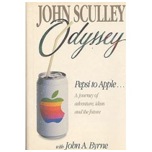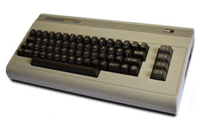




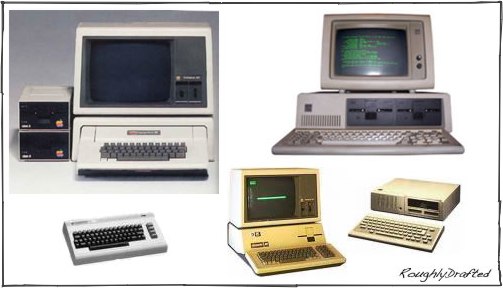
It's important to remember that there is more than one way to maintain a successful platform. Realistically, most upstart competitors realized they had no chance of entirely supplanting the entrenched systems of the time. Most sought to provide alternatives that intended to coexist among a variety of other systems.
At the same time however, the real reason for limited competition in the desktop OS market is closely tied to the advantages of a homogenized market. Developers want to have the widest possible market for their products, and that favors large platforms that can support the critical mass of sales required to survive.
This applies in other software middleware platforms as well: how many media player platforms can the world support? How many video game consoles, and how many embedded operating systems? Clearly, interoperability and migration paths are strong factors in the success of a minority platform. But enough theory! Here's a look at what actually happened, starting with computers in the early 1980's.

Platform Death Match introduced the difficulty of launching a new platform and the work involved in maintaining one. This series looks at the historical march of computing platforms, to sort out why winners won and why losers lost. While the computing environment is always changing, the same basic rules are in effect today, and will shape the future developments between Mac OS X Leopard and Windows Vista.

1980-1985: 8-Bit Platforms
Early computers only needed to launch applications; it was the applications themselves that handled the majority of work in dealing with files, printing, and drawing graphics. That resulted in killer applications driving the adoption of platforms.
In the 70's, adoption of CP/M as a standard platform was driven primarily by the popular text editor WordStar. Similarly, the first popular spreadsheet, VisiCalc, drove sales of the Apple II.

That left customers uncertain about which platform they should invest; what if the next great app happened to get attached to a different set of hardware, leaving their computer obsolete?
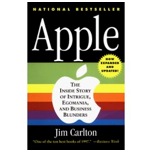 In reality, significant improvements in hardware or software technology quickly rendered existing systems obsolete anyway. The real question was: should new systems seek to build upon and extend existing platforms, or should they introduce entirely new platforms that sever ties to past legacy in order to deliver truly new innovation?
In reality, significant improvements in hardware or software technology quickly rendered existing systems obsolete anyway. The real question was: should new systems seek to build upon and extend existing platforms, or should they introduce entirely new platforms that sever ties to past legacy in order to deliver truly new innovation? The answer is conveniently provided by history, which tells us unequivocally: it depends.
For example, the Apple II enjoyed success as a unique platform based on its simple, easy to extend hardware. The Apple II was not software compatible with CP/M, but could run CP/M programs using an add-on Z80 card. This type of "stop-gap" backwards compatibility has repeated throughout history as the most ideal way to deliver a new platform.
Notable platform lesson: provide an optional, burnable bridge with the past, and use it to lead existing users into a significantly better platform.
Apple's success in releasing an entirely new platform was duplicated by IBM. While Apple offered hardware innovation as the first ready to use, consumer computer system, IBM introduced their new platform largely upon their corporate name and powerful reputation in the business market.
The group at IBM working to introduce a new small computer platform, lead by Don Estridge, originally considered building a powerful system based upon IBM's 801 RISC processor, a precursor to IBM's later POWER architecture. The 801-based PC would have run IBM's own advanced operating system and would have been far ahead of anything existing in the small computer space.
 Instead, the team decided it was more important to ship something quickly, and that it should not compete against IBM's established business machines. The choice of Intel's low end 8088 meant the 1981 IBM PC wouldn't even been a dramatic improvement over the now four year old Apple II!
Instead, the team decided it was more important to ship something quickly, and that it should not compete against IBM's established business machines. The choice of Intel's low end 8088 meant the 1981 IBM PC wouldn't even been a dramatic improvement over the now four year old Apple II! In 1983, Steve Jobs tried to recruit Estridge as president of Apple Computer. Estridge turned Jobs down, and was killed two years later in a commercial plane crash, while flying for IBM. Had he accepted the Apple position, both Estridge and Apple would have experienced a dramatically different future.
 Jobs ended up hiring John Sculley from Pepsi instead. Sculley's decade long Apple legacy involved kicking Jobs out of Apple, jacking up the price of the original Macintosh by 25% to accommodate advertising, licensing away the Mac's IP to Microsoft for Windows, and green lighting all sorts of unprofitable fiascos that put middle managers in control of the company rather than engineers. No doubt an engineer such as Estridge would have made different decisions for the company.
Jobs ended up hiring John Sculley from Pepsi instead. Sculley's decade long Apple legacy involved kicking Jobs out of Apple, jacking up the price of the original Macintosh by 25% to accommodate advertising, licensing away the Mac's IP to Microsoft for Windows, and green lighting all sorts of unprofitable fiascos that put middle managers in control of the company rather than engineers. No doubt an engineer such as Estridge would have made different decisions for the company.The PC market
In the fractured marketplace of 1981, IBM's entry, while not technically sophisticated or novel, provided a seemingly mature foundation for development. IBM had the resources to stay in business and keep up with advances in technology, so buying IBM's PC was an easy decision to make, particularly for businesses.
IBM's stature also brought developers to the new PC. Notable examples are the Lotus 1-2-3 spreadsheet, which copied from VisiCalc and eventually replaced it as the killer app for running numbers, and WordPerfect, which became the new standard for word processing. This support helped the PC to become rapidly established as the new standard, despite being an entirely new platform. Once established, most competitors found little reason to build their own new platforms, and instead sought to copy IBM's hardware, where the real momentum was.
 Existing vendors offering innovations in hardware, like the luggable suitcase computers of Kaypro and Osborne, were caught off guard because they were still trying to sell CP/M. They quickly fell behind and were replaced by Compaq, who offered a similar transportable computer that ran the same DOS software as IBM's PC.
Existing vendors offering innovations in hardware, like the luggable suitcase computers of Kaypro and Osborne, were caught off guard because they were still trying to sell CP/M. They quickly fell behind and were replaced by Compaq, who offered a similar transportable computer that ran the same DOS software as IBM's PC. That demonstrated that hardware innovation isn't enough to float an aging platform, particularly when competitors can match the hardware innovations using a better or at least more popular software platform.
Since little was expected of early disk-based operating systems, it may seem like there should have been more competition for alternatives to DOS. However, there was effectively no market for an alternative DOS for the PC, just as there was little market for an alternative DOS for the Apple II.
Even IBM didn't see any point to writing its own DOS. In order to have a product to ship quickly, IBM PC-DOS was simply licensed from Microsoft; it was actually based largely upon a clone of CP/M. 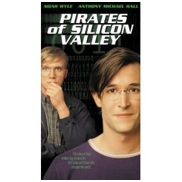

Digital Research, who created CP/M, tried to market a competing product for the PC as DR-DOS, but Microsoft's licensing agreement with IBM and other manufacturers of PC compatibles enabled it to trample Digital Research and other potential competitors out of the market.
Notable platform lesson: it’s difficult to compete against free; bundle software and hardware to avoid competitors getting in the way.
Platform Control
While Apple owned their entire Apple II platform, the IBM PC was a platform built between IBM and Microsoft. That made a vast difference in the outcome of Apple and IBM's attempts to maintain control over the platforms they introduced.
While some seem to think that IBM won a war against Apple by allowing cloners to license their PC design, in reality both Apple and IBM tried to prevent competitors from copying their hardware.
Apple sued Franklin for copying the Apple II ROM and won. IBM's ineffectual efforts to prevent vendors from rolling out PC clones was more difficult because the PC was so easy to copy without legally infringing on any of IBM's technologies.
The Apple II and IBM PC were both successfully cloned eventually. However, PC clones, and in particular Compaq, took hardware leadership away from IBM in the top of the market, while Apple’s clones, notably the Laser 128, targeted a lower end market that wasn’t even addressed by the higher priced Apple II.
While rushing the PC product to market got IBM's platform established, it lost its leadership position for exactly the same reason. Had IBM rolled out a more sophisticated and powerful system even a few years later, they may have risked entering the market late, and possibly may have faced a more dominant Apple or entrenched market for CP/M.
That seems unlikely in retrospect however; instead, a stronger entry from IBM almost assuredly would have cleaned up the market anyway, and would have also been harder for competitors to copy, simply because IBM would have owned the entire platform, and it would have required far more sophistication to clone.
The PC was built from readily available commodity parts; had IBM released the advanced PC brewing its its labs, it would have owned the platform from chip fabrication to software, and cloners would have been stuck with copying CP/M, the Apple II, or trying to introduce an entirely new platform.
On the software side, Microsoft had little difficulty in preventing competition. After Compaq and others cloned the IBM PC hardware, they readily signed up with Microsoft for its MS-DOS; that effectively took hardware market share away from IBM, and entrenched Microsoft's DOS as the standard, and the driver of the PC platform.
Notable platform lesson: don’t release technology that is easy to copy and expect to maintain ownership, and don’t partner with cutthroats.
The non-PC Market
The Apple II continued to sell to home and education markets, but never gained much of a foothold among business users, where the PC was quickly becoming the de facto standard.
 Apple's first major failure, the Apple III, hoped to compete against IBM's PC in the business market using an entirely new platform. The Apple III actually appeared a year before the IBM PC, but failed to gain any traction in the market for a number of tragic platform mistakes.
Apple's first major failure, the Apple III, hoped to compete against IBM's PC in the business market using an entirely new platform. The Apple III actually appeared a year before the IBM PC, but failed to gain any traction in the market for a number of tragic platform mistakes.First, the Apple III intended to offer an entirely new platform with only limited compatibility with the Apple II; it purposely couldn't use many of the Apple II's more advanced features. The III also earned notoriety for hardware problems resulting from being rushed to market. The Apple III offered little advancement over the Apple II, and it was more expensive than other CP/M computers, so it likely would have failed even if IBM's PC hadn't been introduced just in time to nail it dead.
Apple's sloppy efforts to deliver a poor quality product were also copied by IBM. While IBM's PC and its clones filled out the emerging business market, IBM attempted to enter Apple's home and education market with a new platform of its own: the PC jr.
It failed miserably, for many of the same reasons as the Apple III. It offered few benefits over the Apple II or its competitors, it was overpriced, it delivered crippled compatibility with the IBM PC, and its quality was criticized, particularly its innovative wireless keyboard.
Notable platform lesson: sloppy, incompatible cousin platforms are not a good money maker.
Other computers of the time, the popular Commodore 64, a series of home computers from Atari, and the Coleco Adam, were related to the Apple II in that they used the same processor and delivered similar features for home users.
The C-64's improved graphics and sound features and its low price made it wildly popular as a home computer and games system. Coleco and Atari proved that simply offering a cheaper alternative wasn't enough to develop a sustainable platform.
Platform Perception vs. Reality
IBM is largely given credit for establishing the business PC market. However, the PC platform was really driven by Microsoft. IBM not only handed the software reigns to Microsoft, but they also lost hardware leadership and their market share to cloners.
Notable platform lesson: there isn't much room to compete within a platform, and there can be only one driver.
Apple was one of the few companies to maintain its 8-bit platform long enough to earn the capacity to jump to the next level. Apple was already busy working on its next major platform: a powerful, graphical computing environment that would become the Macintosh. While released in 1984, I'll present the Mac and its competitors in the next epoch of computing: 1985-1990.
This Series

| | Comment Preview
 Read more about:
Read more about:

 Send |
Send |

 Subscribe |
Subscribe |
 Del.icio.us |
Del.icio.us |
 Digg |
Digg |
 Furl |
Furl |
 Reddit |
Reddit |
 Technorati
Technorati
Click one of the links above to display related articles on this page.
1980-1985: 8-bit Platforms
Monday, August 28, 2006






Ad





